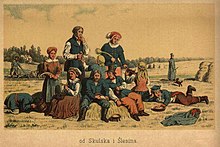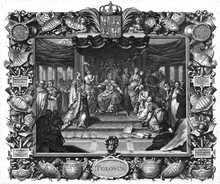Poland (ethnicity)

The Poles are a West Slavic ethnic group . They make up 96.74% of the total population in the Republic of Poland (2002 census). There is also a worldwide Polish diaspora , especially in Ukraine , Belarus , Lithuania and various states in Central and Western Europe and North and South America.
Poles speak Lechian Polish , a West Slavic language, and the majority of them belong to the Roman Catholic Church . Denominational minorities are Orthodox Christians and Protestants . Religious minorities are the Jews and the Muslims, including the autochthonous minority of the largely Polonized Muslim Lipka Tatars .
The term “Poland” (Polish: Polacy ) is derived from the Indo-European word “pole” ( field ); the same as its semantic equivalents - falen , Champagne , and Campania . "Inter Alpes Huniae et Oceanum est Polonia, sic dicta in eorum idiomate quasi Campania", wrote the legal scholar Gervasius of Tilbury in his Otia Imperalia in 1211 . According to this, the name of Poland is derived from the "field inhabitants".
Origin and settlement area

The original settlement area of the Poles is around the Warta and the nets in the region of the cities of Posen (Poznań) and Gniezno (Gniezno) . As early as the early Middle Ages, the West Slavic Polans living there united with the Wislanes , who lived around today's cities of Kraków (Kraków) and Warsaw (Warszawa) . Other former West Slavic tribes were the highlanders who Slesanen that Masovians , the Cracow's and others.
With the establishment of the Jagiellonian Empire Poland-Lithuania , many Poles settled in what is now southeastern Lithuania , what is now the western half of Belarus and what is now the western third of Ukraine , as well as in northern Moravia and northern Slovakia .
In the 19th century, with industrialization, many Poles settled in the Ruhr area ( Ruhr Poland ) and in the industrial centers of Austria-Hungary . After the Second World War , the Poles were expelled from their homeland by the Soviet Union from the area east of today's eastern border of Poland ( Curzon Line ) and moved to East Pomerania , East Prussia with Warmia and Masuria , Pomerania and Gdansk , East Brandenburg and Lower Silesia as well as in Upper Silesia instead of the German population previously expelled from these areas .
The 2011 census showed that 93% of Kashubians and 51% of Silesians see themselves as Poles at the same time.
Polish diaspora
In the past 200 years, Poles emigrated to different parts of the world, where they assimilated to different degrees.
It is estimated that there are 44 to 60 million Poles worldwide.
As historical and recognized national minorities, Poles live in many Central and Eastern European countries: Latvia (2.5% of the population), Lithuania (6.74%), Slovakia (0.1%), the Czech Republic (0.5%), Ukraine (0.45%), Hungary (3800), Belarus (4%). Many Poles emigrated to Western European countries.
Other destinations for Polish emigrants were Brazil (1 million people of Polish origin), France (1 million, one of the best-known relatives was Marie Curie ), Germany (2 million people of Polish origin), Kazakhstan (25,000), the USA (10.6 million Polish people) Americans ) and Canada (650,000). There are also around 850,000 people of Polish descent in Great Britain and around 120,000 immigrants in Ireland since Poland joined the EU. In addition, Poles also live in Argentina , South Africa , Australia , Russia , Romania , Sweden , Belgium , Denmark , the Netherlands , Austria , Greece and Italy . In Iceland and Norway they are the largest minority.
The number of Poles in France is given as 1,050,000 and in Canada as 800,000. Of the more than 10 million Americans of Polish origin (2000 US census), only 667,414 people (0.25% of the population) speak Polish at home.
Large parts of Polish emigrants have assimilated over time. If all people are included who had Polish ancestors in the last 150 years, this results in a total of over 100 million people.
For the members of the Polish diaspora, a certificate was introduced that confirms that their owner belongs to the Polish people: the Karta Polaka .
Poland in Germany
The number of Poles currently living in the Federal Republic of Germany cannot be precisely quantified. According to the 2011 census , two million people with a Polish migration background live in Germany. In Poland, too, it is assumed that there are two million people (estimates by the Wspólnota Polska Foundation , 2007) with a wholly or partially Polish ethnic, cultural or linguistic identity. The number of people with exclusively Polish citizenship is 740,962 (2015); In addition, around 690,000 (2011) people with German and Polish citizenship live in Germany.
Poland on the territory of the former Soviet Union
In 1992 an estimated 1.13 million Poles lived in the successor states of the Soviet Union , most of them in Lithuania, Belarus and the Ukraine (compare with the figures above).
Poles have immigrated to this part of the Polish-Lithuanian Empire since the 14th century. Up until the 20th century, they formed the politically and socio-economically dominant stratum in what is now Lithuania, Ukraine and Belarus. Due to the three partitions of Poland-Lithuania between 1772 and 1795, most of the part came to the Russian Empire , the core of Poland was first called Congress Poland , then the Vistula region . The Second Polish Republic , which was established in 1918, gained territories in several wars with predominantly Polish-speaking regions in the east, but lost these areas again in 1939 as a result of the Hitler-Stalin Pact , and finally in 1945 through the border treaty concluded with the Soviet Union . Most of the Poles living there were then resettled in the new western areas of the People's Republic of Poland , but another part remained in their former homeland. Today there are still strong Polish minorities in Lithuania and Belarus, as well as smaller groups in the Ukraine and other successor states of the Soviet Union. The Polish minority in Lithuania and the Polish minority in Belarus should be emphasized here .
Poland in Hungary
The Polish minority in Hungary was very populous in the middle of the 19th century. The first permanent Sunday school was founded in 1922. During the Second World War there were 27 Polish primary schools in Hungary and - unique in Europe - a Polish university and a lyceum in Balatonboglár . Officials put the current number of Poles in Hungary at 3,800, while minority organizations estimate the number at 10,000.
See also
Web links
Individual evidence
- ↑ Dieter Bringen, Krzysztof Ruchniewicz (Ed.): Country Report Poland. Federal Agency for Civic Education, Bonn 2009, ISBN 978-3-593-38991-2 , p. 362.
- ^ Joseph Bosworth: A dictionary of the Anglo-Saxon languages, p. 275; planus, plain, flat ; from Indo- Germanic pele , flat, to spread, also the root of words like plan, floor, and field. [In:] John Hejduk: Soundings, 1993, p. 399; “The root pele is the source of the English words 'field' and 'floor'. The root 'plak' is the source of the English word 'flake' ”. [In:] Loren Edward Meierding: Ace the Verbal on the SAT, 2005, p. 82.
- ↑ "Tak jak nazwa Polanie, również nazwa Polska pochodzi od pół uprawnych, podobnie jak nazwa Szampania we Francji (od le champ - pole) czy Kampania we Włoszech (od campo - pole)." In: Jerzy Topolski : Historia Polski. Wydawnictwo Poznańskie, p. 42.
- ↑ Structure narodowo-etniczna, językowa i wyznaniowa ludności Polski - NSP 2011 , Główny Urząd Statystyczny.
- ^ Fischer Weltalmanach 2006, ISBN 3-596-72006-0
- ↑ ssb.no: Immigration and immigrants 2010 (PDF; 1.2 MB)
- ↑ CIA World Factbook
- ^ Census database - results of the 2011 census. May 9, 2011, accessed on April 25, 2015 .
- ^ Wspólnota Polska - Polonia w liczbach.
- ↑ Number of foreigners from Poland in Germany from 2007 to 2015
- ↑ Four million Germans have two passports , zeit.de
- ^ Rudolf A. Mark : The peoples of the former Soviet Union. 1992
- ↑ Page no longer available , search in web archives: Mailing List of Flags of the world
